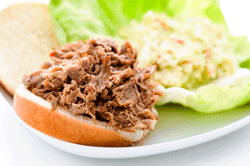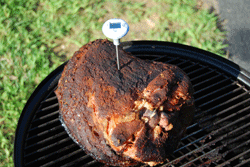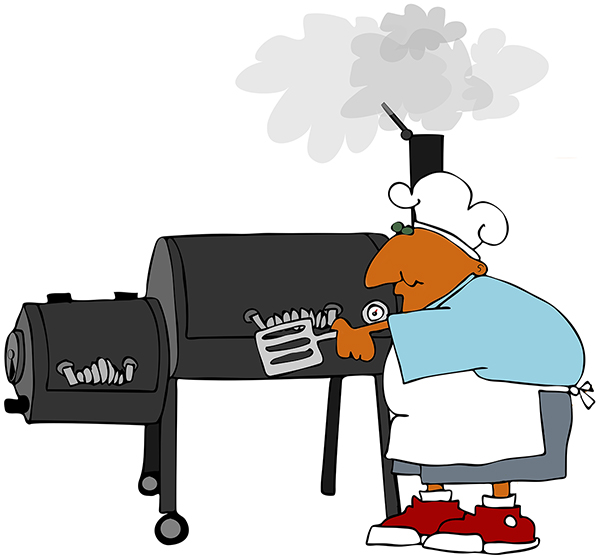Secrets of Pork Barbeque for Great Pulled Pork!
This page will give you the steps for cooking the larger pork barbeque cuts (butts, picnics). These meat cuts, when seasoned just right, make delicious, smoky flavored, Pulled Pork and other pork barbeque recipes.
 The new cook will find that the steps are relatively easy but it does take patience. Real barbeque cooking, in general, takes patience. The 30 minute cook need not apply.
The new cook will find that the steps are relatively easy but it does take patience. Real barbeque cooking, in general, takes patience. The 30 minute cook need not apply.
Your patience with the methods will be greatly rewarded with succulent, flavorful barbeque.
The good barbeque cook needs to know a little something about the different cuts of meat on a hog and where the best cuts for pork barbeque are located. The shoulder is the cut of choice for most barbeque cooks. Many barbeque pros also like the challenge of whole hog barbeque
You can buy the whole shoulder but many supermarkets divide into to top portion (Boston Butt) and the lower portion (Picnic). Both are active muscles that have a lot of connective tissue and tend to be tough but very flavorful.
These cuts found their way into the barbeque arena originally because tough cuts of meat require slow and low cooking preparation.
Next, let’s get started on the cooking steps:
 The first thing you want to do is to clean and dry the meat followed by trimming the shoulder of excess fat.
The first thing you want to do is to clean and dry the meat followed by trimming the shoulder of excess fat.
The area closest to the skin usually has the most fat. Don’t get too elaborate with trimming (this is not competition cooking).
Just trim the exposed areas of excess fat (when the meat is done and you start to pull the meat apart you will also discard a fair amount of excess fat).
 The second step seasoning the shoulder.
The second step seasoning the shoulder.
Injection marinades are flavor enhancers. The simplest ones are usually the best. We use a mixture of apple cider vinegar, apple juice, water and Worcestershire sauce.
Now you don’t have to use an injection marinade but it’s a nice enrichment. If you inject marinade do this before you put on your dry rub.

Speaking of dry rubs?…..to ensure that the dry rub “sticks” to the surface you may want to prepare the surface by moistening with yellow mustard or olive oil. Massage the meat with the mustard or oil (to make sure it is covered) and then sprinkle on a heavy layer of your dry rub spice combination.
If you do this, more of your dry rub stays in contact with the meat and it forms a spicy crust all around your shoulder.
Now that you have your spices on the meat you must let it marinate. A simple plastic sealable container works very well for marinating.
Marinate in the refrigerator for at least 2 hours and preferably 24.
We’ve recently switched to using our FoodSaver machine for marinating. If you are not familiar with these machines they allow the home user to vacuum seal food for refrigeration and freezing.
It does a great job of marinating because vacuum sealing the seasoned meat seems to force more of the marinade to soak in.
 Third, once the meat is marinated then you are ready for the
Third, once the meat is marinated then you are ready for the
smoker.
The smoker temperature should be in the range of 225 to 250 degrees. Your shoulder will cook for approximately 8-10 hours.
You will be able to pinpoint when done by monitoring the internal temperature of the meat.
Remember from the basic steps on the “How to Barbeque” page that you should wrap your shoulder in foil about two thirds
into the cooking process or when the internal temperature of the meat is about 180 degrees.
 If you use one of those specialized
If you use one of those specialized
meat thermometers that flashes when the meat done (depending on the type of meat) keep in mind that even if it says that pork is done (at 170 degrees) your pork barbeque is not done. The meat is done when it reaches an internal temperature of approximately 190-195 degrees.
Another test for doneness is the “bone” test. At 190 degrees check the blade bone by pulling on it. If it looks like it
will come out easily the meat is done. If you have resistance then let it cook a while longer.
Increase the temperature
slightly if you have to (using the heating characteristics of your smoker).
An “instant read” digital meat thermometer is a very helpful device for monitoring the internal temperature of the shoulder. A remote temperature probe with an alarm is even more helpful.


